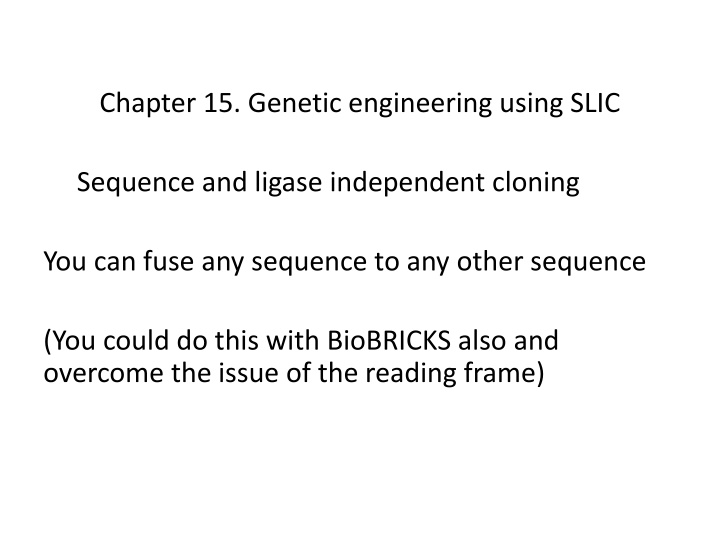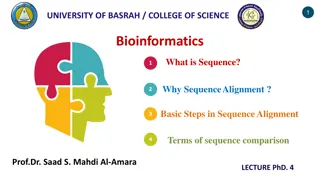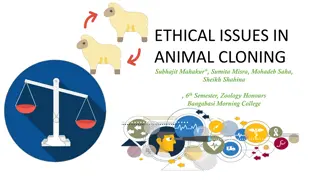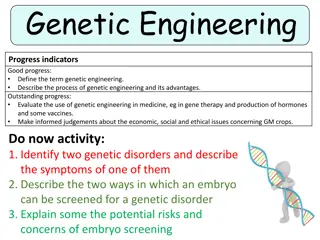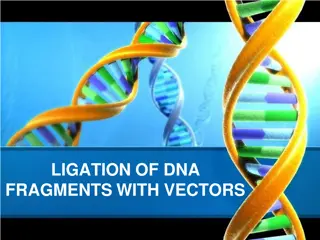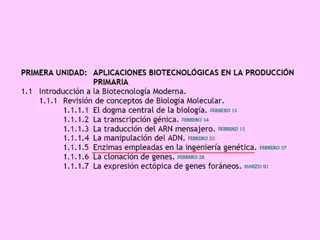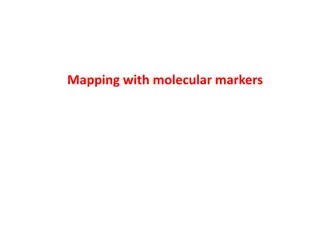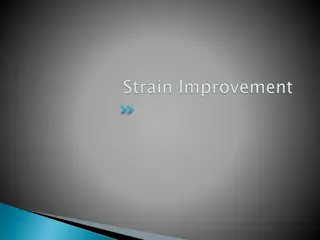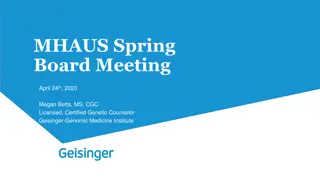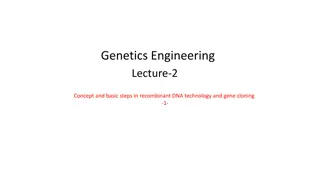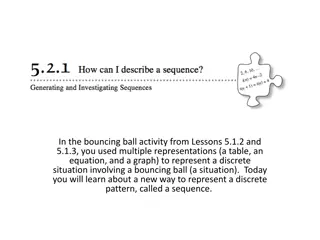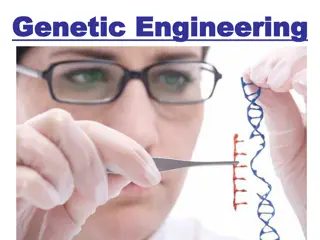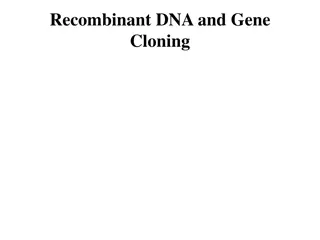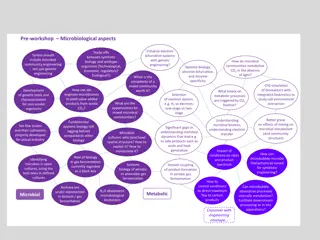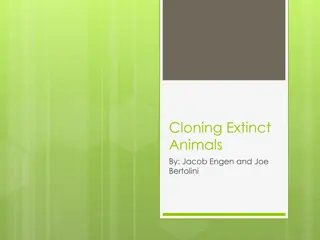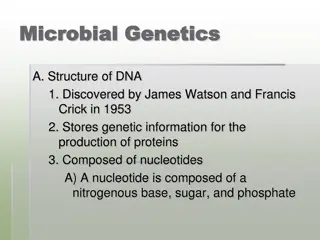Genetic Engineering Using SLIC Sequence and Ligase Independent Cloning
Genetic engineering techniques like SLIC allow the fusion of DNA sequences without restriction enzymes, providing flexibility in creating gene fusions. This involves using DNA polymerases to create single-stranded overhangs for precise sequence assembly. The process utilizes both polymerase and exonuclease activities to generate specific overhangs, essential for joining different DNA fragments seamlessly. By designing primers strategically, gene fusions encoding novel proteins can be achieved effectively.
Download Presentation

Please find below an Image/Link to download the presentation.
The content on the website is provided AS IS for your information and personal use only. It may not be sold, licensed, or shared on other websites without obtaining consent from the author.If you encounter any issues during the download, it is possible that the publisher has removed the file from their server.
You are allowed to download the files provided on this website for personal or commercial use, subject to the condition that they are used lawfully. All files are the property of their respective owners.
The content on the website is provided AS IS for your information and personal use only. It may not be sold, licensed, or shared on other websites without obtaining consent from the author.
E N D
Presentation Transcript
Chapter 15. Genetic engineering using SLIC Sequence and ligase independent cloning You can fuse any sequence to any other sequence (You could do this with BioBRICKS also and overcome the issue of the reading frame)
SLIC - sequence and ligase independent cloning +15 base 5 additions to primers that are identical to plasmid ends and PCR In the absence of dNTPs, exonuclease activity of T4 DNA polymerase digests 3 ends (short incubation) addition of dCTP stops digestion at G in template After annealing at room temp., the mixture is transformed into E. coli. single-stranded gaps are filled in and ends ligated by enzymes in E. coli. http://j5.jbei.org/j5manual/pages/22.html
How can we use DNA polymerases to make single stranded overhangs? You use polymerases with both polymerases and exonuclease activity You can stimulate the endonuclease activity by adding the polymerase (plus buffer, water, and the vector or insert) but NO NUCLEOTIDES T4 DNA polymerase will generate a 5 overhang with 3 -5 exonuclease activity T5 DNA polymerase will generate a 3 overhang with 5 - 3 exonuclease activity The exonuclease activity is timed to generate the desired length of overhang and then the reaction is stopped by adding a large amount of just one nucleotide. This stimulates the polymerase activity Consider why only ONE nucleotide is added. What would happen if we added a lot of all four nucleotides
Figure shows protein A end of ORF and beginning of protein B ORF (Figure ignores the rest of the genes and focuses on primers at fusion site) Design primers to fuse by SLIC to generate a gene that encodes an A+B fusion protein: ORF A ORF B 5 atg aca cgg cgg tgc tcg cacnnn 3 tac tgt gcc gcc acg agc gtgnnn M T R R C S H 5 gag ggg agg ctg cag aaa cct ctc atc gaa tat atg gtc gag cgg gct tga3 3 ctc ccc tcc gac gtc ttt gga gag tag ctt ata tac cag ctc gcc cga act 5 E G R L Q K P L I E Y M V E R A - 1. to generate fusion ORF with these specifications: 2. ORF A 18 nucleotide (nt) right primer with 15 nt overlap, and 18 nt ORF B left primer without overlap
Design primers to fuse by SLIC to generate a gene that encodes an A+B fusion protein: ORF A ORF B 5 gag ggg agg ctg cag aaa cct ctc atc gaa tat atg gtc gag cgg gct tga3 3 ctc ccc tcc gac gtc ttt gga gag tag ctt ata tac cag ctc gcc cga act 5 E G R L Q K P L I E Y M V E R A - 5 atg aca cgg cgg tgc tcg cacnnn 3 tac tgt gcc gcc acg agc gtgnnn M T R R C S H As always, start with the end product you are trying to generate: 1. to generate fusion ORF DELETE STOP CODON, MAINTAIN TRIPLET ORF FRAME 5 gag ggg agg ctg cag aaa cct ctc atc gaa tat atg gtc gag cgg gct atg aca cgg cgg tgc tcg cac nnn3 3 ctc ccc tcc gac gtc ttt gga gag tag ctt ata tac cag ctc gcc cga tac tgt gcc gcc acg agc gtg nnn 5 E G R L Q K P L I E Y M V E R A M T R R C S H tga cac ggc ggt gct cgc acnnn act gtg ccg cca cga gcg tgnnn STOP example of consequence of NOT maintaining ORF - deletion of A in ATG results in immediate STOP codon
Design primers to fuse by SLIC to generate a gene that encode a A+B fusion protein: The fusion product you want to generate: 5 gag ggg agg ctg cag aaa cct ctc atc gaa tat atg gtc gag cgg gct atg aca cgg cgg tgc tcg cac nnnn3 3 ctc ccc tcc gac gtc ttt gga gag tag ctt ata tac cag ctc gcc cga tac tgt gcc gcc acg agc gtgnnn 5 E G R L Q K P L I E Y M V E R A M T R R C S H This is the fusion site 5 gag ggg agg ctg cag aaa cct ctc atc gaa tat atg gtc gag cgg gct atg aca cgg cgg tgc tcg cac nnnn3 3 ctc ccc tcc gac gtc ttt gga gag tag ctt ata tac cag ctc gcc cga tac tgt gcc gcc acg agc gtgnnn 5 E G R L Q K P L I E Y M V E R A M T R R C S H Gene specific sequence Overlap
Design primers to fuse by SLIC to generate a gene that encode a A+B fusion protein: ORF A ORF B 5 atg aca cgg cgg tgc tcg cacnnn 3 tac tgt gcc gcc acg agc gagnnn M T R R C S H 5 gag ggg agg ctg cag aaa cct ctc atc gaa tat atg gtc gag cgg gct tga3 3 ctc ccc tcc gac gtc ttt gga gag tag ctt ata tac cag ctc gcc cga act 5 E G R L Q K P L I E Y M V E R A - 2. ORF A 18 nucleotide (nt) right primer with 15 nt overlap, and 18 nt ORF B left primer without overlap 5 gag ggg agg ctg cag aaa cct ctc atc gaa tat atg gtc gag cgg gct atg aca cgg cgg tgc tcg cac nnn3 3 ctc ccc tcc gac gtc ttt gga gag tag ctt ata tac cag ctc gcc cga tac tgt gcc gcc acg agc gtg nnn5 E G R L Q K P L I E Y M V E R A M T R R C S H 5 gag ggg agg ctg cag aaa cct ctc atc gaa tat atg gtc gag cgg gct atg aca cgg cgg tgc tcg cac 3 3 ctc ccc tcc gac gtc ttt gga gag tag ctt ata tac cag ctc gcc cga tac tgt gcc gcc acg agc gtg 5 E G R L Q K P L I E Y M V E R A M T R R C S H
Design primers to fuse by SLIC to generate a gene that encode a A+B fusion protein: ORF B ORF A 5 atg aca cgg cgg tgc tcg cac nnnn 3 tac tgt gcc gcc acg agc gag nnnn M T R R C S H 5 gag ggg agg ctg cag aaa cct ctc atc gaa tat atg gtc gag cgg gct tga3 3 ctc ccc tcc gac gtc ttt gga gag tag ctt ata tac cag ctc gcc cga act 5 E G R L Q K P L I E Y M V E R A - 2. ORF A 18 nucleotide (nt) right primer with 15 nt overlap, and 18 nt ORF B left primer without overlap 5 gag ggg agg ctg cag aaa cct ctc atc gaa tat atg gtc gag cgg gct atg aca cgg cgg tgc tcg cacnnnn 3 3 ctc ccc tcc gac gtc ttt gga gag tag ctt ata tac cag ctc gcc cga tac tgt gcc gcc acg agc gagnnnn 5 E G R L Q K P L I E Y M V E R A M T R R C S H 5 atg aca cgg cgg tgc tcg cacnnn 3 3 tac tgt gcc gcc acg agc gtgnnn 5 After PCR (just the edges of the pieces that will be fused): 5 gag ggg agg ctg cag aaa cct ctc atc gaa tat atg gtc gag cgg gct atg aca cgg cgg tgc tcg 3 3 ctc ccc tcc gac gtc ttt gga gag tag ctt ata tac cag ctc gcc cga tac tgt gcc gcc acg agc5 5 gag ggg agg ctg cag aaa cct ctc atc gaa tat atg gtc gag cgg gct atg aca cgg cgg tgc tcg cac 3 3 ctc ccc tcc gac gtc ttt gga gag tag ctt ata tac cag ctc gcc cga tac tgt gcc gcc acg agc gag 5 E G R L Q K P L I E Y M V E R A M T R R C S H
After PCR generating overlap: 5 atg aca cgg cgg tgc tcg cac 3 3 tac tgt gcc gcc acg agc gag 5 5 gag ggg agg ctg cag aaa cct ctc atc gaa tat atg gtc gag cgg gct atg aca cgg cgg tgc tcg 3 3 ctc ccc tcc gac gtc ttt gga gag tag ctt ata tac cag ctc gcc cga tac tgt gcc gcc acg agc5 After T4 DNA polymerase/exonuclease, exonuclease digestion: ORF B 5 atg aca cgg cgg tgc tcg cac nnnnnnnnnnnn3 nnnnnnnn 5 5 gag ggg agg ctg cag aaa cct ctc atc gaa tat atc gtc 3 ctc ccc tcc gac gtc ttt gga gag tag ctt ata tac cag ctc gcc cga tac tgt gcc gcc acg agc 5 After annealing of overlaps: 5 gag ggg agg ctg cag aaa cct ctc atc gaa tat atc gtc atg aca cgg cgg tgc tcg cac nnnnnnnnn 3 3 ctc ccc tcc gac gtc ttt gga gag tag ctt ata tac cag ctc gcc cga tac tgt gcc gcc acg agc nnnnnn 5 After transformation and repair in E. coli cells: 5 gag ggg agg ctg cag aaa cct ctc atc gaa tat atg gtc gag cgg gct atg aca cgg cgg tgc tcg cac 3 3 ctc ccc tcc gac gtc ttt gga gag tag ctt ata tac cag ctc gcc cga tac tgt gcc gcc acg agc gag 5 E G R L Q K P L I E Y M V E R A M T R R C S H
Design primers to fuse by SLIC to generate a gene that encodes an A+B fusion protein: ORF B ORF A 5 atg aca cgg cgg tgc tcg cac 3 tac tgt gcc gcc acg agc gag M T R R C S H 5 gag ggg agg ctg cag aaa cct ctc atc gaa tat atg gtc gag cgg gct tga3 3 ctc ccc tcc gac gtc ttt gga gag tag ctt ata tac cag ctc gcc cga act 5 E G R L Q K P L I E Y M V E R A - 3. ORF B 18 nt left primer with 15 nt overlap, and ORF A 18 nt right primer without overlap 5 gag ggg agg ctg cag aaa cct ctc atc gaa tat atg gtc gag cgg gct atg aca cgg cgg tgc tcg cac 3 3 ctc ccc tcc gac gtc ttt gga gag tag ctt ata tac cag ctc gcc cga tac tgt gcc gcc acg agc gag 5 E G R L Q K P L I E Y M V E R A M T R R C S H 4. 18 nt primers with 15 nt overlaps generating a total of 30 nucleotides of overlap 5 gag ggg agg ctg cag aaa cct ctc atc gaa tat atg gtc gag cgg gct atg aca cgg cgg tgc tcg cac 3 3 ctc ccc tcc gac gtc ttt gga gag tag ctt ata tac cag ctc gcc cga tac tgt gcc gcc acg agc gag 5 E G R L Q K P L I E Y M V E R A M T R R C S H Do these as homework send me your answers and I ll give feedback
